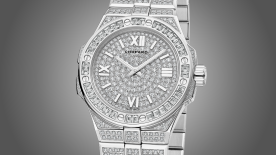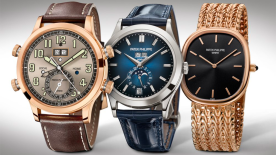It's so easy to get confused about the Cartier collection array. It's so wide. And it used to be ever wider six years ago when the brand was a juggernaut of high watchmaking. Most of their complicated watches were housed in a case called Rotonde. It was the most flexible and easiest to pair with the huge variety of movements, sizes, thicknesses and complications that Cartier offered back then. As a consequence, the Rotonde's personnality was completely overshadowed by the otherwise very expressive dials, skeletons and flaoting tourbillons.
It's a shame because the Rotonde is a wonderful fit. And in order to really appreciate it, the best option is to try one of its simple iterations. As a matter of fact, I'm thinking of a piece that made a lasting impresison on me, the blue Rotonde de Cartier Chronograph. Introduced during the 2015 SIHH, it had gone mostly unnoticed. Back then, Cartier was in the habit of introducing twenty to thirty major novelties every year. It was easy not to pay too much attention to such a simple men's watch.
In hindsight, it's a real shame because Cartier didn't have a dress chronograph in its catalogue. A piece that would have been just a chronograph, not coupled with another compication, that would have had a simple, classical display, not exotic, not sporty, not sporty chic. And there still isn't one today either. This is the only classy chrono from Cartier. Classy, yes indeed! Its curved flanks, long curvy lugs, beaded crown, curved bezel all came in a full polished finish that made this a prestigious case. And at 40 mm, it was perfect on every wrist.

The blue dial had its share of surprises. Stamped with a flower-like pattern that's typical Cartier, it had a silver minute track, white counters and vivid white printed Roman numerals (a must for Cartier).The most surprising about it was its Breguet hands, with hollowed rings near the tip, because Cartier almost exclusively goes for the sword-shaped ones. The trotteuse deserved a special mention. Its was slim and so long it went well into the railroad minute track, almost up to the flange. There aren't many such slender hands around. Overall, the dial was ornemental, but not loaded with information, and very refined.

The movement was an in-house, integrated, automatic calibre called 1904-CH MC. Let me tell you a little bit about this one. When Cartier launched their first in-house movement, the 1904 MC, they had in fact begun by desiging it as a chronograph. The three-hander version was actually derived from it. They just didn't add the chronograph components. This flexible structure was the hallmark of this uniquely smart movement, which Cartier has been using in a wide variety of shapes and functions ever since. The rectangular pushers had the merit of not meddling too much with the sleek caseband line. Under the finger, they were quite comfortable because they were wide and also because the movement's action was very smooth.
The Rotonde de Cartier is still available today, in steel with silver dial or rose gold with silver dial. But their blue cousin is long gone and it's a real shame becasue it was years ahead of the blue craze, and uniquely refined within the brand's collections.





